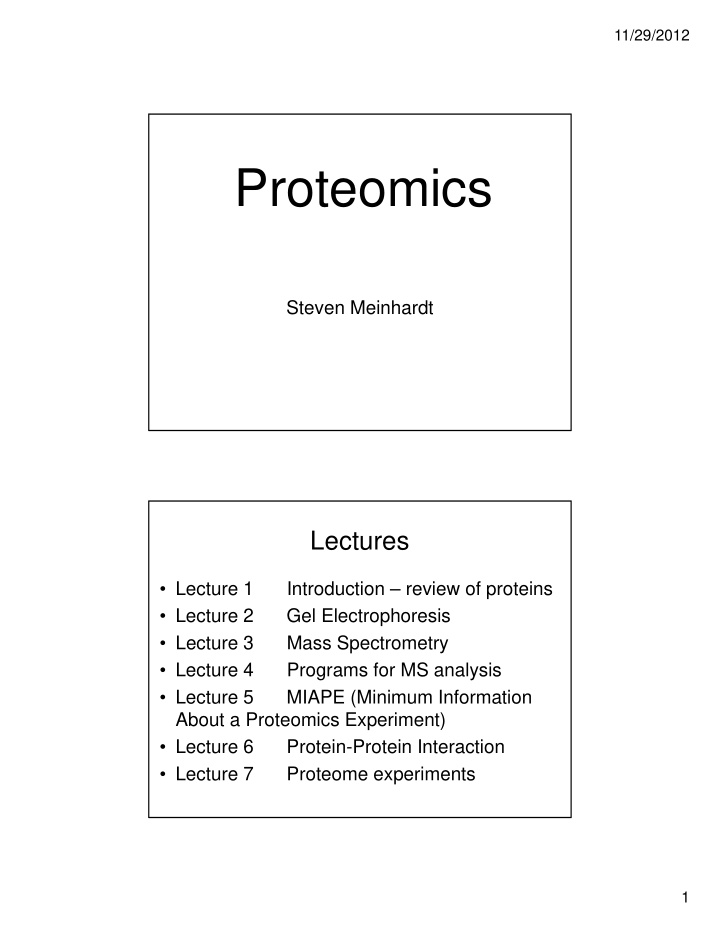



11/29/2012 Proteomics Steven Meinhardt Lectures • Lecture 1 Introduction – review of proteins • Lecture 2 Gel Electrophoresis • Lecture 3 Mass Spectrometry • Lecture 4 Programs for MS analysis • Lecture 5 MIAPE (Minimum Information About a Proteomics Experiment) • Lecture 6 Protein-Protein Interaction • Lecture 7 Proteome experiments 1
11/29/2012 Review of Proteins • Composition and Structure – Amino Acids • 20 common amino acids • Other amino acids – Other components • Cofactors – Metals Hemes vitamins (cobalmin) – Others – Modifications Common Amino Acids There are 20 common amino acids Name Three Single Name Three Single Letter Letter Letter Letter Code Code Code Code Alanine Ala A Methionine Met M Cysteine Cys C Asparagine Asn N Aspartate Asp D Proline Pro P Glutamate Glu E Glutamine Gln Q Phenylalanine Phe F Arginine Arg R Glycine Gly G Serine Ser S Histidine His H Threonine Thr T Isoleucine Ile I Valine Val V Lysine Lys K Tryptophan Trp W Leucine Leu L Tyrosine Tyr Y Asp or Asn B Glu or Gln X 2
11/29/2012 Protein Modification • Modified amino acids (15) – (A, C, D, E, H, K, L, M, N, P, R, S, T, V, W, Y) – Hydroxylation (C, D, I, K, L, N, P, V, W) – Glycosylation (S, T, N, (OH)P) – Sulfination (S, T, Y) – Phosphorylation (S, T, Y) – Oxidation Methionine sulfoxide, sulfone (C) – Selenocysteine (U) • Browse by modification • http://dbptm.mbc.nctu.edu.tw/browse.php Proteomics volume 4 Issue 6 , Pages 1525 - 1853 (June 2004) http://www.ebi.ac.uk/RESID/ 532 different amino acid modifications. (2010) Amino Acid Modification – Acetylation (n-terminal and K or C) • Cyclization of N-terminal glutamine to make pyroglutamate – Fatty acid addition (K, C, N- and C-terminus) – ADP-Ribosylation (H, N, R, and K) – Disulfide bond formation (C) – Methylation (A, C, E, F, H, K, M, N, P, Q, R) • N-terminal phenylalanine and C-terminal C 3
11/29/2012 Protein Modification • Ubiquitin or SUMO addition – Ubiquitin signals degradation • Ubiquitin (76aa, 8.5 kDa) is transferred to lysine in target protein • Degradation occurs in proteosome – SUMO signals retention (Small Ubiquitin like Modifier • SUMO (~12 kDa) attaches to lysine in target • Helps control trafficking • consensus motif Ψ -K-x-D/E ( Ψ is hydrophobic) • Proteolytic processing – SUMO (activated by removal of last 4 amino acids) – Insulin Cofactors • Metals – Fe, Cu, Mo, Zn, Mn, Mg, Co, W, Se – Other molecules S, I • “Small” Organic Molecules – AMP ADP ATP cyclic-AMP – GMP GDP GTP cyclic-GTP – Coenzyme A Coenzyme Q Vit K RNA – FAD+ or FADH2 NAD+ or NADH – Porphyrins (Hemes and chlorophyll) – FeS clusters – Cobalamin Thiamine pyridoxine folic acid • Others Allosteric regulatory molecules 4
11/29/2012 Protein Structure • Some portions of proteins are cleaved. – Signal sequence • Excretion, mitochondria, chloroplast, golgi, nucleus – Prosequence – Internal sequence • Mature protein – final protein after cleavages and or modification, usually functional Protein Structure • Primary (amino acid sequence) • Secondary – Helix, beta turn, parallel and antiparallel beta sheet. – Triple Helix • Tertiary – Proteins fold into common structures • All and the four helix bundle • -barrel -clamshell • helix-turn-helix • E-F Hand • Quarternary – Multisubunit structures 5
11/29/2012 Examples of structures Common helical structures 4 helix bundle Coiled-coil EF Hand 6
11/29/2012 Function • What do proteins do? • Things that affect that function. – Location • Proteins move • Function changes with location • Tissue specificity • Soluble vs membrane bound – Modifications – Association with other proteins – Expression (temporal, spatial, amount) Protein Regulation • Transcription • Translation • Proteolysis – Activiation – Ubiquitin – Small Ubiqitin-like Modifier (SUMO) • Phosphorylation • Dissociation • Binding of signal, substrate, product, etc. • Concentration 7
11/29/2012 Basic Proteomics Information • Composition • Structure • Function • Regulation • Location • Interactions • Quantity 8
Recommend
More recommend